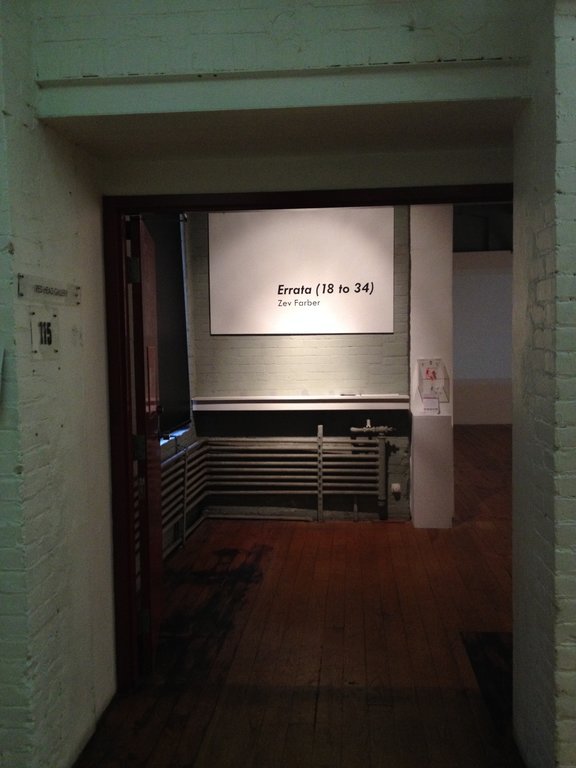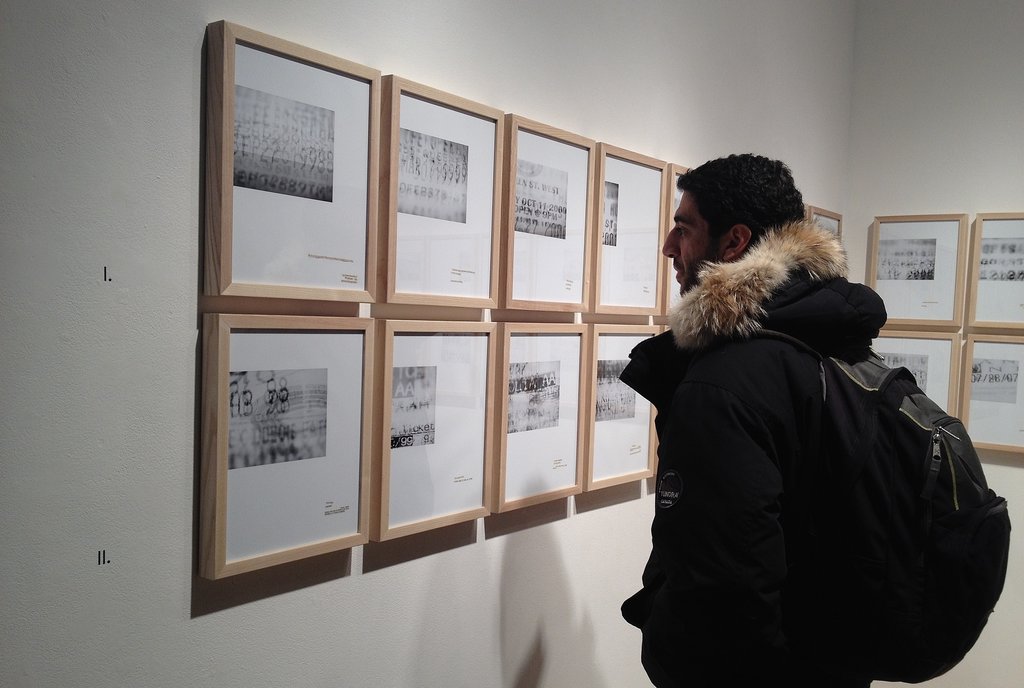Upon entry, the ominous atmosphere of Farber’s Errata Sheet (Persistent Tinnitus and Imperfect Recall) filled the gallery space. Eerie enough to send shivers up your spine, Farber’s autobiographical exhibition features a multi-media presentation of a formative period in his life. Without prior knowledge of the details and conceptual ideas behind his trilogy of works, his engages his viewer with a mesmerizing, yet foreboding video projection and audio, as well as recognizable objects (tickets) paired with obscure and ambiguous/cryptic phrases like “but the damage was done.”
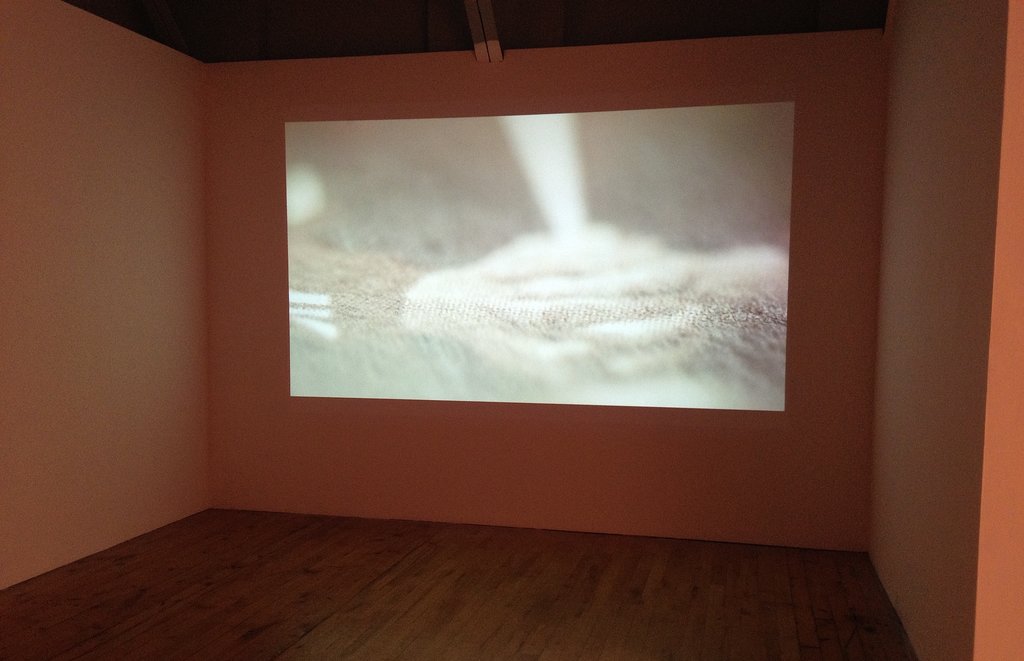 Errata Sheet (Persistent Tinnitus and Imperfect Recall), 2014, Film Comment, Vol.36-50, Nov/Dec 1998- Sept/Oct 2013, 8 Sounds of Tinnitus, Courtesy of American Tinnitus Association; HD Video 4 min.46 sec.
Errata Sheet (Persistent Tinnitus and Imperfect Recall), 2014, Film Comment, Vol.36-50, Nov/Dec 1998- Sept/Oct 2013, 8 Sounds of Tinnitus, Courtesy of American Tinnitus Association; HD Video 4 min.46 sec.
Upon piquing my curiosity, I wondered about the relationship between these ambiguous phrases and the repeating image of superimposed tickets. The relationship between image, archival material, sound, and text, as explained by gallery administrator Emilia Ziemba, found root in the themes of loss and memory, as well as the tension between destructive and creative impulses.
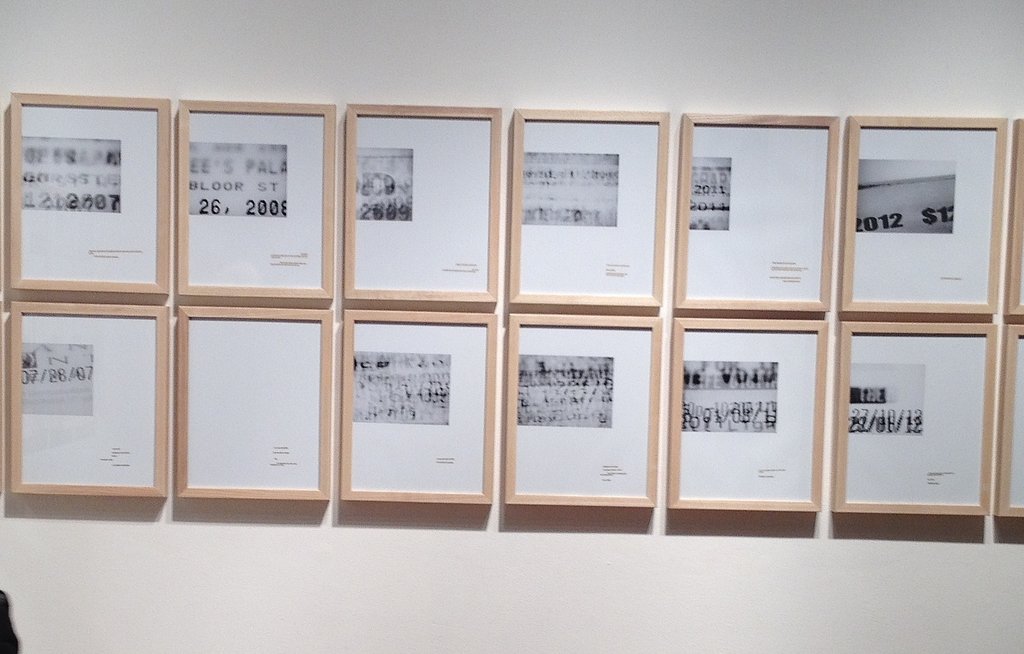 Row I. The Following Errors Have Been Found (Sound 1998-2013), 2014, 61 Concert Tickets, LOOK Magazine, Vol.31, 1968 Keepsake Issue; 16 Framed Digital Prints, each 11 x 14 inches
Row I. The Following Errors Have Been Found (Sound 1998-2013), 2014, 61 Concert Tickets, LOOK Magazine, Vol.31, 1968 Keepsake Issue; 16 Framed Digital Prints, each 11 x 14 inches
Row II. The Following Errors Have Been Found (Vision 1998-2013), 2014, 89 Movie Tickets, TV Guide, Vol.11, January 25-31, 1964; 16 Framed Digital Prints, each 11 x 14 inches
The two rows of 16 framed digital prints (each print representing one year in his life, from ages 18 to 34) instantly caught my eye upon entering the gallery space. They feature a collection of tickets from 61 concerts and 89 movies that he attended over the period of 16 years. Each year is represented by an image of superimposed tickets and accompanying text. The Following Errors have been found (Sound 1998-2013) features text taken from LOOK magazine in reference to the assassination of Robert Kennedy, while the The Following Errors have been found (Vision 1998-2013) includes text from an issue of TV Guide in reference to the assassination of John F. Kennedy. Referencing two momentous occasions in American history, the notion of loss and broken bonds, is much more personal than it seems since the textual material was found in the home of a recently deceased friend of the artist. Moreover, the relationship between the text and the images brightly highlight loss, and memory.
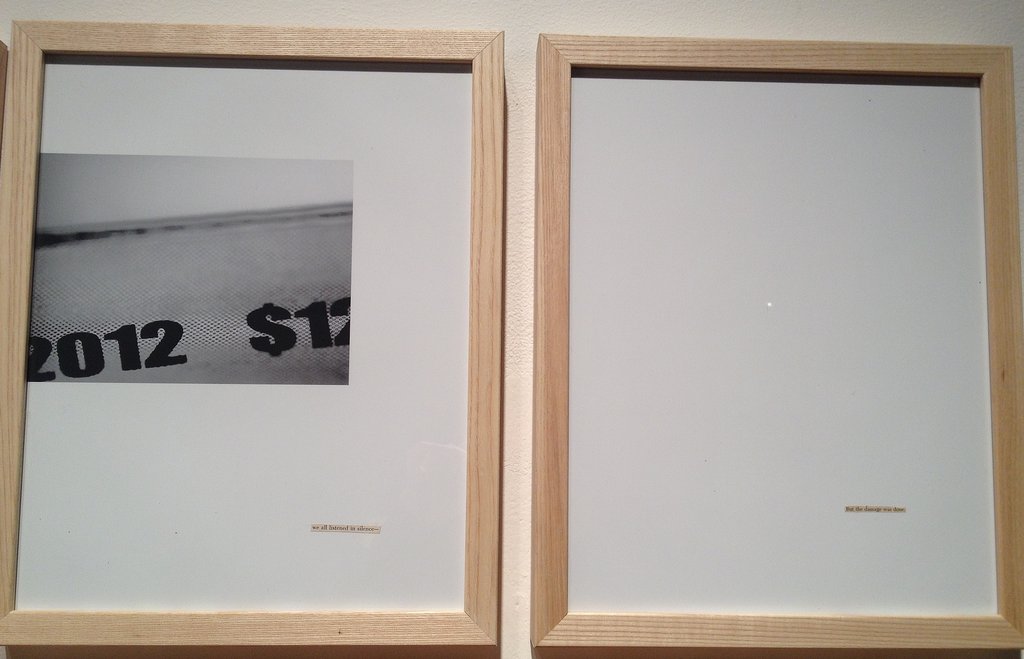 The Following Errors Have Been Found (Sound 1998-2013), 2014, 61 Concert Tickets, LOOK Magazine, Vol.31, 1968 Keepsake Issue; 16 Framed Digital Prints, each 11 x 14 inches. Note: the absence of an image indicates that Farber did not attend a film or concert over the course of that year.
The Following Errors Have Been Found (Sound 1998-2013), 2014, 61 Concert Tickets, LOOK Magazine, Vol.31, 1968 Keepsake Issue; 16 Framed Digital Prints, each 11 x 14 inches. Note: the absence of an image indicates that Farber did not attend a film or concert over the course of that year.
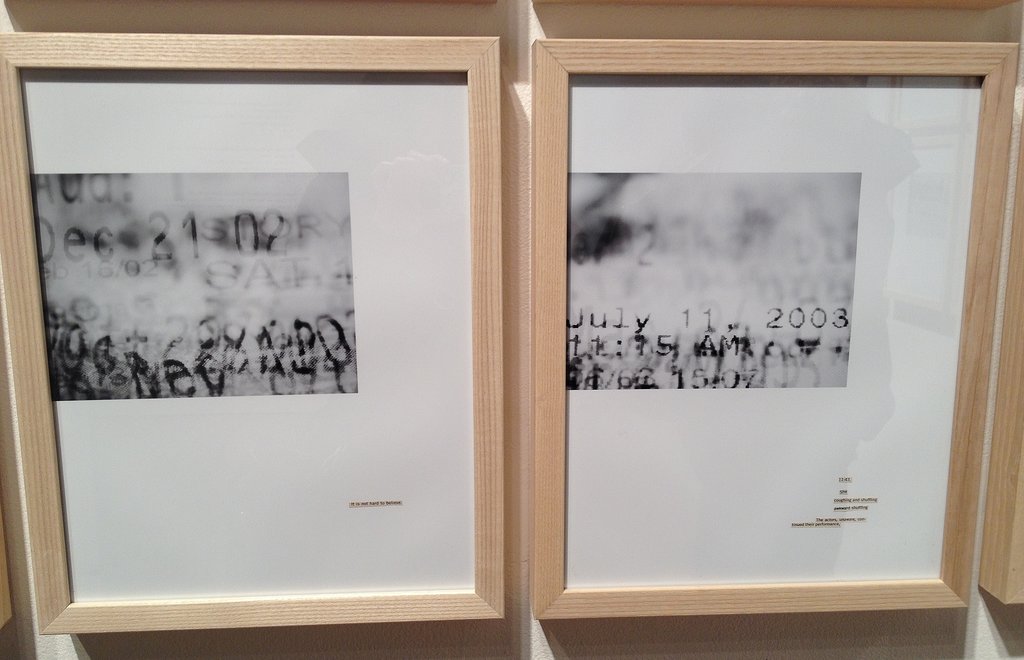 The Following Errors Have Been Found (Vision 1998-2013), 2014, 89 Movie Tickets, TV Guide, Vol.11, January 25-31, 1964; 16 Framed Digital Prints, each 11 x 14 inches
The Following Errors Have Been Found (Vision 1998-2013), 2014, 89 Movie Tickets, TV Guide, Vol.11, January 25-31, 1964; 16 Framed Digital Prints, each 11 x 14 inches
The themes of loss, destructive/creative impulses become increasingly direct with Farber’s audio-visual piece, Errata Sheet (Persistent Tinnitus and Imperfect Recall). Taped in one shot, without any editing, we see errata sheets and images from Film Comment magazine as well as 8 sounds of tinnitus from the American Tinnitus Association. His desire to enjoy expressions of creativity (150 films/concerts over the course of 16 years) has resulted in the development of a damaging physical condition, Tinnitus (Latin for “ringing”, and is defined by the Mayo Clinic as “noise or ringing in the ears”). Similar to the irreversible grammatical errors or typos in a publication, Farber will have to live with this uncomfortable and permanently damaging condition for the rest of his life. Furthermore, the exhibition title directly alludes to the destructive result of the well-intentioned desires. Although Farber’s trilogy of works may seem morbid and pessimistic, he vulnerably offers his audience the opportunity to appreciate and relate to his growth as a human being and as an artist by exhibiting his past, its consequences, and an uncertain future.
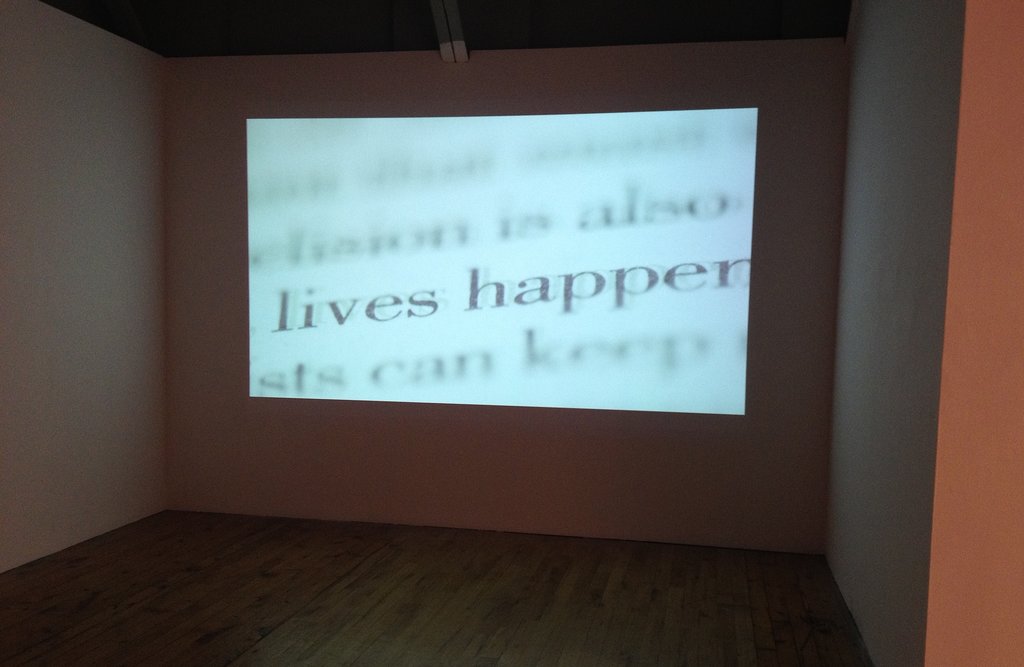 Errata Sheet (Persistent Tinnitus and Imperfect Recall), 2014, Film Comment, Vol.36-50, Nov/Dec 1998- Sept/Oct 2013, 8 Sounds of Tinnitus, Courtesy of American Tinnitus Association; HD Video 4 min.46 sec.
Errata Sheet (Persistent Tinnitus and Imperfect Recall), 2014, Film Comment, Vol.36-50, Nov/Dec 1998- Sept/Oct 2013, 8 Sounds of Tinnitus, Courtesy of American Tinnitus Association; HD Video 4 min.46 sec.
On the Closing Reception I (L.S.) asked a few questions from Zev Farber (Z.F.)
L.S.: The Red Head Gallery director, Emilia Ziemba, described you as being a private person. Would you consider this exhibition to be one of the most difficult to date because it required a personal and autobiographical, vulnerability?
Z.F.: I really did. The two preceding installations were, one fictional, and the other autobiographical, so this one really challenged me to see how far I was willing to push, or rather, make public the autobiographical side of things, which is sort of an interesting challenge amongst other challenges that I am glad to set out for myself. So, absolutely.
L.S.: What caused the shift from a fictional story about the disappearance of a family with If it Happened At All, It Happened This Way, and a non-fictional installation about forty years in the life of Greg McRoberts, to your autobiographical installation, Errata (18-34)?
Z.F.: The first installation was born out of my MFA thesis and it really gave me something to sink my teeth into that didn’t keep me inside my own space. It freed me up in terms of thinking about materials, thinking about process in terms of thinking about narrative and I really found that that was something I wanted further, and work with further. I am a bit of a process oriented thinker, so the idea of a trilogy helped. I like threes. I like triptychs. It worked together nicely. I knew this was coming and it was interesting to see how comfortable I would become with the content as it was developing
L.S.: What have been some of the challenges, emotional or technical, that you’ve encountered while working on Errata (18-34)?
Z.F.: Um…technical, absolutely. One of the elements that are different in this exhibition [in comparison to If it Happened At All, It Happened This Way, and Greg McRoberts] is that there is an element of the handmade, with the application of the collage elements went into these prints. I feel much more comfortable working at a remove where there is a digital barrier between the audience and the material. So in this case, I was throwing myself out there at the risk of the hand/mark-making. It is all working in terms of personal property and personal experience. That was the only risky element: the hand-made, the mark-making, of the collage itself, not layering digital. I think for an audience, maybe, it draws them a little bit closer to otherwise abstract images.
L.S.: The exhibition title Errata (18-34) hints at mistakes that cannot be rectified in text, as well as your medical condition, Tinnitus. The sounds of tinnitus in Errata Sheet (Persistent Tinnitus and Imperfect Recall) created an ominous atmosphere in the gallery space, which continued to haunt me after I left the space. How is it to live with Tinnitus on a daily basis? Do you feel as if the atmosphere in the gallery faithfully embodies the condition’s effect on your life?
Z.F.: Within the work, using tinnitus was sort of a strategy to evoke the idea of losing something. It’s the idea of a permanent loss. Living with Tinnitus on a daily basis, it’s a very unpredictable relationship because it comes and goes. For instance, it happened to me this morning and hasn’t happened since, and maybe it’ll come back in one ear, maybe in both ears. I deal with it on a very unpredictable basis. I assume that it will become a permanent resident in my head at some point, so, that’s my relationship to the Tinnitus itself, and then by manipulating these variations on how Tinnitus might sound like, this was my way of taking control of it to bring myself to come to grips with it. So taking it from this oppositional stand-point, bringing it a little bit closer, it’s actually physically close.
I did actually struggle with the idea of how, if there was, how to weave it in and out of the installation because the audience themselves would find it aggressive, so again that was interesting question: how aggressive do I want to be with the audience, or even with our gallery administrator. These were all considerations that I had to throw into the mix. It is interesting that you have to make these decisions on your own, and live with the results within a space.
L.S.: You don’t appear in any of the photographs; however, your property is on display. Why and how did you select these tickets to represent the past 16 years of your life?
Z.F.: It is because, for me, the one consistency between 18 and 34 was building my own cultural identity. So, for me that was film and music. I studied music in my undergrad and my one escape from the world was going through the film books and journals in Robarts Library at UofT. It has followed me to this point, even though there were no movies or concerts in 2013. So I have used that as the formation of that cultural identity, it was the most personal thing I could offer anybody. That, for me, was the most interesting and most universal thing, opposed to other things that have happened in my life like marriage, having a child, going throughout schooling, employment experiences. All these other universal things happen, but for me, this was the one consistency. I haven’t held onto anything else from the age of 18 except these tickets.
L.S.: That was my next question, since it seemed as if you were a sentimental collector-of-things, what are the other things you collect, if there are other things you collect?
Z.F.: I have a huge record collection and a huge collection of films. You see all of this come together through those types of collections. For me this is a way of indexing emotional experiences, locating them in specific time, places, dates. You can see fragments of addresses, and you know that it’s Toronto through things like Queen St. West, and other elements are really abstract, but you can also recognize the Cineplex Odeon logo. So it is all meant to be of a place, but not of a place, of a time, but not of a time.
L.S.: Emilia told me something interesting, that the text used in these images are commenting on the assassination of Robert and J.F. Kennedy that was previously property of a friend, who has recently passed away. Why use magazine excerpts commenting on the deaths of the Kennedys’ as the text in The Following Errors Have Been Found?
Z.F.: This person that had passed away, their partner gave me this collection he had and said, “Just do something with it, give it some life, turn it into something else.” So I focused on drawing on Robert Kennedy’s assassination and John Kennedy’s assassination and transforming these historic moments, big cultural moments and seeing if I could find my way into any of that, even though I had no access to it. But they [Zev’s friend and his partner] did. So it was a way for me to try and get closer to them through their own collection and archive and draw elements that I could, then, repurpose. And to be honest, these magazines were real collectors’ items, so I had to make the choice to destroy them, right? They’re no longer collectable, they’ve been defaced.
L.S.: Do you consider that your life, thus far, communicated through the exhibit as a cautionary tale?
Z.F.: I can agree that, tonally, there is definitely this ambience of not caution, but a dramatic tone. I tend to move towards the dramatic. And I guess I am surprised to see how that emerged even in this work. In my personal life, I think there is much more to celebrate than there is, in any way, to reflect on poorly, which I’m proud of. There are no regrets, but there are moments that, through this show, I was trying to address that are always going to be unsolvable, unfixable. That’s the idea behind the titling of the show, and some of the works, these errors can never be corrected. It was a way for me to think back on those moments and just address the reality of what they were, but in a really abstract way. I will agree with you, the tone is foreboding, but I don’t think I would ever tell anyone else, “don’t jump right in with your own two feet and live your life to its fullest”
Text and photo: Leanne Simaan
*Exhibition dates: January 8 – February 1, 2014 , The Red Head Gallery, 401 Richmond St.W , suite #115. Gallery hours: Wed – Sat 12 – 5 p.m.

